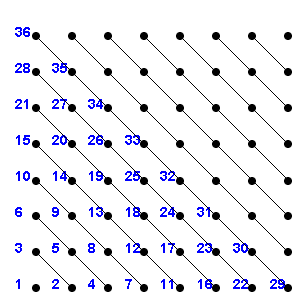|
Home | 18.013A | Chapter 1 | Section 1.2 |
||
|
|
||
Is Q countable?
Solution:
Each rational number r in Q is a numerator in Z divided by a denominator in N. It is characterized then by the pair (a, b) such that r = a / b. If we look at all pairs (a, b) for a in Z and b in N, we will actually get every r over and over again, as a / b, (2a) / (2b), (3a) / (3b),...
Therefore if we can list all the pairs (a, b) for a in Z and b in N we can get a list of the elements of Q by throwing away duplicates on this list.
Imagine then that we have a vertical column for each b in N and that column consists of a list of the elements of Z (as in Exercise 1.1). We can list the resulting pairs by going up every diagonal as in the illustration below. This will give a list of every pair (a, b) for a in Z and b in N.
You run through the elements of N much faster than you do the elements of Q but again nobody cares about this fact.
To be explicit, we order the elements n of our array in increasing order of a+b and for fixed a+b in increasing order of i.
Thus the first few ratios in this order are
1/1, 1/2, 2/1, 1/3, 2/2, 3/1, 1/4, 2/3, 3/2, 4/1, ...
The first of these has a + b = 2 then there are two with a + b = 3, three with a + b = 4, and so on.
The ratio ![]() will
then appear as the ratio in the position
will
then appear as the ratio in the position ![]() on
the list.
on
the list.
You can enter any ratio below and see where it occurs on the list and vice versa.

|
|